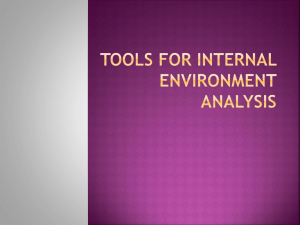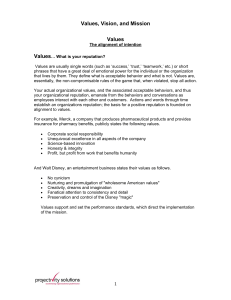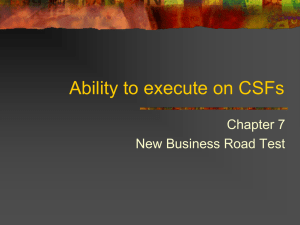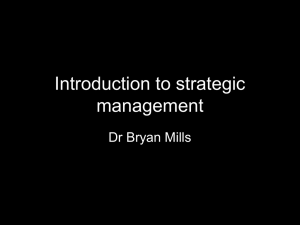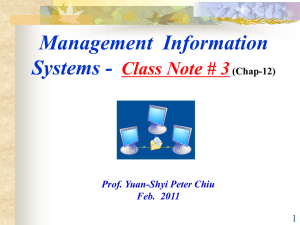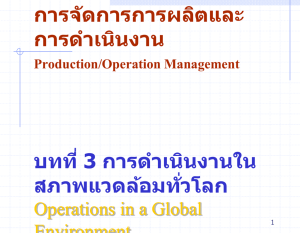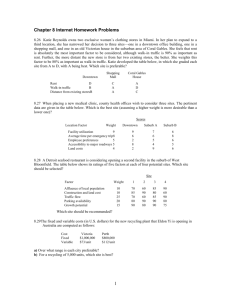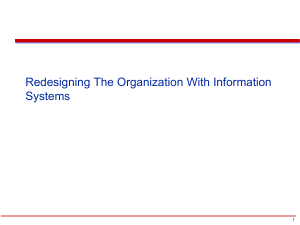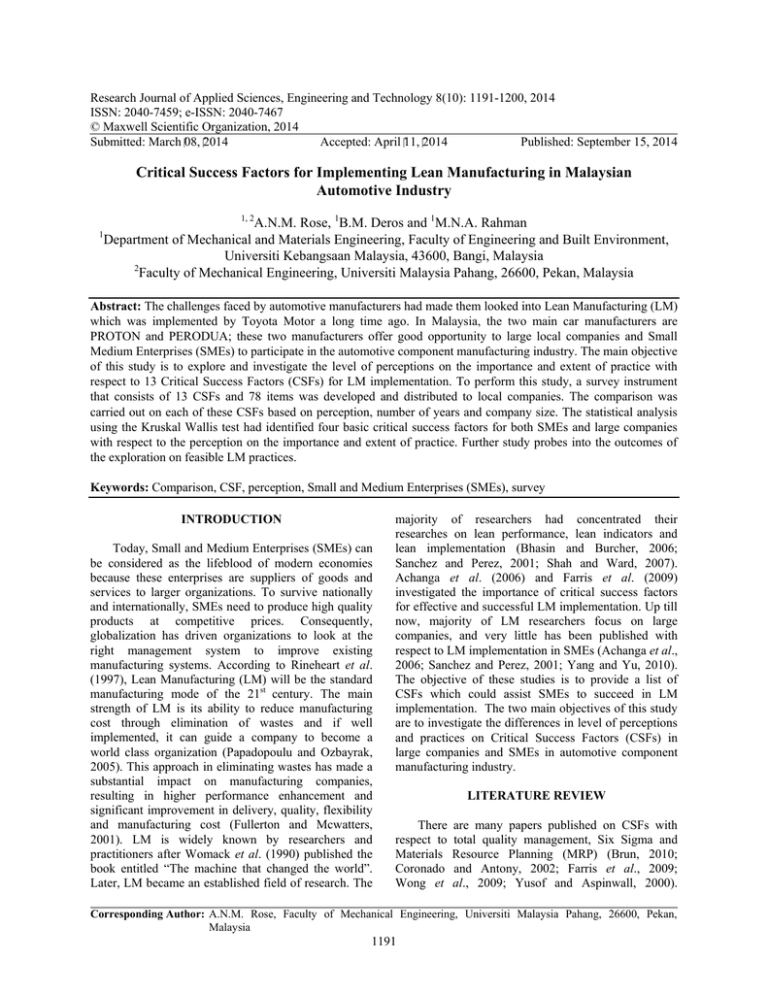
Research Journal of Applied Sciences, Engineering and Technology 8(10): 1191-1200, 2014
ISSN: 2040-7459; e-ISSN: 2040-7467
© Maxwell Scientific Organization, 2014
Submitted: March 08, 2014
Accepted: April 11, 2014
Published: September 15, 2014
Critical Success Factors for Implementing Lean Manufacturing in Malaysian
Automotive Industry
1, 2
A.N.M. Rose, 1B.M. Deros and 1M.N.A. Rahman
Department of Mechanical and Materials Engineering, Faculty of Engineering and Built Environment,
Universiti Kebangsaan Malaysia, 43600, Bangi, Malaysia
2
Faculty of Mechanical Engineering, Universiti Malaysia Pahang, 26600, Pekan, Malaysia
1
Abstract: The challenges faced by automotive manufacturers had made them looked into Lean Manufacturing (LM)
which was implemented by Toyota Motor a long time ago. In Malaysia, the two main car manufacturers are
PROTON and PERODUA; these two manufacturers offer good opportunity to large local companies and Small
Medium Enterprises (SMEs) to participate in the automotive component manufacturing industry. The main objective
of this study is to explore and investigate the level of perceptions on the importance and extent of practice with
respect to 13 Critical Success Factors (CSFs) for LM implementation. To perform this study, a survey instrument
that consists of 13 CSFs and 78 items was developed and distributed to local companies. The comparison was
carried out on each of these CSFs based on perception, number of years and company size. The statistical analysis
using the Kruskal Wallis test had identified four basic critical success factors for both SMEs and large companies
with respect to the perception on the importance and extent of practice. Further study probes into the outcomes of
the exploration on feasible LM practices.
Keywords: Comparison, CSF, perception, Small and Medium Enterprises (SMEs), survey
INTRODUCTION
Today, Small and Medium Enterprises (SMEs) can
be considered as the lifeblood of modern economies
because these enterprises are suppliers of goods and
services to larger organizations. To survive nationally
and internationally, SMEs need to produce high quality
products at competitive prices. Consequently,
globalization has driven organizations to look at the
right management system to improve existing
manufacturing systems. According to Rineheart et al.
(1997), Lean Manufacturing (LM) will be the standard
manufacturing mode of the 21st century. The main
strength of LM is its ability to reduce manufacturing
cost through elimination of wastes and if well
implemented, it can guide a company to become a
world class organization (Papadopoulu and Ozbayrak,
2005). This approach in eliminating wastes has made a
substantial impact on manufacturing companies,
resulting in higher performance enhancement and
significant improvement in delivery, quality, flexibility
and manufacturing cost (Fullerton and Mcwatters,
2001). LM is widely known by researchers and
practitioners after Womack et al. (1990) published the
book entitled “The machine that changed the world”.
Later, LM became an established field of research. The
majority of researchers had concentrated their
researches on lean performance, lean indicators and
lean implementation (Bhasin and Burcher, 2006;
Sanchez and Perez, 2001; Shah and Ward, 2007).
Achanga et al. (2006) and Farris et al. (2009)
investigated the importance of critical success factors
for effective and successful LM implementation. Up till
now, majority of LM researchers focus on large
companies, and very little has been published with
respect to LM implementation in SMEs (Achanga et al.,
2006; Sanchez and Perez, 2001; Yang and Yu, 2010).
The objective of these studies is to provide a list of
CSFs which could assist SMEs to succeed in LM
implementation. The two main objectives of this study
are to investigate the differences in level of perceptions
and practices on Critical Success Factors (CSFs) in
large companies and SMEs in automotive component
manufacturing industry.
LITERATURE REVIEW
There
respect to
Materials
Coronado
Wong et
are many papers published on CSFs with
total quality management, Six Sigma and
Resource Planning (MRP) (Brun, 2010;
and Antony, 2002; Farris et al., 2009;
al., 2009; Yusof and Aspinwall, 2000).
Corresponding Author: A.N.M. Rose, Faculty of Mechanical Engineering, Universiti Malaysia Pahang, 26600, Pekan,
Malaysia
1191
Res. J. Appl. Sci. Eng. Technol., 8(10): 1191-1200, 2014
Table 1: Highlighted factors for lean manufacturing implementation in SMEs
Item
1
2
3
4
5
6
7
8
Management leadership and commitment
*
*
*
*
*
*
*
*
Training and education
*
*
*
*
*
*
Employee involvement
*
*
*
*
*
Customer management involvement
*
*
*
Supplier management involvement
*
*
*
Quality management
*
*
*
Effective communication
*
*
*
Organizational culture
*
*
Empowerment of employees
*
*
Continuous improvement
*
*
Human resource management
*
Effective communication
*
1: Ferdousi and Ahmed (2009); 2: Kumar and Anthony (2008); 3: Real et al. (2007); 4: Achanga et al. (2006); 5: Saleheldin (2005); 6: Motwani
(2003); 7: Yauch and Steudel (2002); 8: Chang and Lee (1996)
Rokart (1979), a pioneer in CSF, defined CSFs as the
“areas in which results, if they are satisfactory, will
ensure successful competitive performance for the
organization”. Meanwhile, Saraph et al. (1989) who
pioneered the study of CSFs for Total Quality
Management (TQM) defined CSFs as those “critical
areas of managerial planning and actions that must be
practiced in order to achieve effectiveness in a business
unit”. Deros et al. (2006) believed CSFs could act as an
agent to initiate successful change. Achanga et al.
(2006) highlighted that CSFs must be present in order
to ensure successful LM implementation. Saleheldin
(2009) posited that CSFs should be strived for mission
achievement towards new management system
implementation. Similarly, Kumar and Antony (2008)
concluded that LM implementation may fail if
organizations do not practise these CSFs such as top
management commitment, training and customer
involvement. These managerial activities and practices
must be pursued to ensure LM implementation success
in the organization (Yusof and Aspinwall, 2000). Based
on thoroughly reviewed and recent LM publications,
there are 12 CSFs being highlighted and discussed
extensively and they are summarized in Table 1. The
three major LM factors, such as top management
commitment, training and education, and employee
involvement have been widely discussed in the existing
literature. This study reviews and analyses CSFs,
highlighted by previous researchers and practitioners in
Total Quality Management (TQM) and LM such as
Ferdousi and Ahmed (2009), Saleheldin (2009), Kumar
and Antony (2008), Real et al. (2007), Abdullah (2006),
Achanga et al. (2006), Ahrens (2006), Saleheldin
(2005), Motwani (2003), Antony et al. (2002), Yauch
and Steudel (2002), Yusof and Aspinwall (2000) and
Chang and Lee (1996). Most of the papers studied CSFs
for LM implementation in large companies but not in
SMEs. Therefore, the authors strongly believed that
there is a need to conduct CSFs studies for LM
implementation in SMEs involved in automotive
component manufacturing industry.
Malaysian SMEs was defined as companies with
number of full time employees between five to 150
employees and annual sales turnover between RM251k
to RM25 million (SME Corp., 2010).
METHODOLOGY
The research methodology used was survey
questionnaire. The questionnaire was adopted and
adapted from survey instruments used by previous
researchers, such as Fullerton et al. (2003) and Shah
and Ward (2007). The CSFs were selected based on
comprehensive reviews of related papers in LM and
TQM with the notion that both LM and TQM are
interrelated with each other. At the early stage, the
CSFs gathered comprised of 12 factors and 78
elements. Respondents were asked to rate the level of
importance and practice of these CSFs within their
companies. In this survey, a 5 point Likert rating scale
was used to measure the level of importance, from 1not important to 5-very important. Meanwhile, for the
level of practice, from1-not implemented to 5-highly
implemented. This scale was used to measure the extent
of implementation of CSFs within the respective
companies. As a part of the validation process, the
questionnaire was given to ten experts (5 practitioners
and 5 academicians) in LM to get their comments with
respect to its contents, length, structure and language
used. As a summary of their comments, the experts
suggested to the authors to reduce the total number of
CSFs; meanwhile, each CSF should have at least 6 subfactors. Reliability and validity tests were conducted on
the questionnaire using guidelines provided by
Sakakibara et al. (1993) and Flynn et al. (1994).
Reliability is an evaluation of measurement
consistency, whereas validity test is to determine the
quality of measurement instrument on what was
claimed to be measured. Internal consistency was used
for analyzing the reliability of each factor. In general,
the agreed alpha for good reliability is 0.70; however,
alpha 0.60 is still acceptable for exploratory research
(Flynn et al., 1994). The internal consistency was
performed separately on each of the 12 factors using
SPSS V.17.
A pilot test was conducted to ensure the
constructed questionnaire is reliable and valid.
According to Palaniappan (2009), the minimum number
of samples for a validity test is 30. Meanwhile, Wong
1192
Res. J. Appl. Sci. Eng. Technol., 8(10): 1191-1200, 2014
et al. (2009) gathered feedbacks from 50 respondents in
their survey questionnaire’s validation process. In the
pilot test, the questionnaire was accompanied with a
support letter to increase respondents’ motivation to
answer the questionnaire (Dillsman, 1978). To do this,
the questionnaire was sent to 100 respondents’
companies where 30 survey questionnaires were
completed and returned, giving a response rate of 30%.
Later a reliability test was conducted on the
questionnaire to measure the respondents’ rating
consistency. Comments made by the respondents were
taken into consideration in enhancing the quality of the
questionnaire. The main objective was to improve on
the questions, making them easily understood by the
respondents. The questions were then checked for their
reliability and validity.
RESULTS AND DISCUSSION
Survey results: Initially, 250 questionnaires were
distributed by postal and electronic mail to potential
respondents. Unfortunately, only 27 completed
questionnaires were returned by the respondents, giving
a poor response rate of 10.8%. Due to this poor
response rate, the authors decided to contact a
department of an automotive vendor developer from
one of the National Car Manufacturers to garner some
support on potential respondents. In March 2011, the
authors’ application was approved where the authors
were given a time slot during a vendor briefing
programme and annual quality presentation. On that
day, the authors personally distributed the questionnaire
to all 157 participants. At the end of both programmes,
70 sets of completed usable questionnaires were
collected which gave a response rate of 44.6%. Finally,
the total number of completed and returned survey
questionnaires rose to 97 sets where this number is
adequate for performing the SPSS analysis (Chavez
et al., 2013).
Respondents’
demographic
background:
Respondents of this survey comprised of Chief
Executive Officer (CEO), General Managers (GM),
Senior Manager, Production Manager, Quality
Assurance/Quality Control (QA/QC) Manager and
Production Engineer/Executive. The authors believed
that they are the right people to answer the
questionnaire. Table 2 shows their respective
designations or positions in their respective companies.
Referring to Table 2, almost 58% of the respondents are
working in the production department (i.e., Production
Manager,
QA/QC
Manager
and
Production
Engineer/Executive). This is expected because LM
normally starts and is being practiced at the production
line to eliminate wastes such as inventory, motion and
quality.
The respondents were categorized according to
their place of work such as SMEs and large companies.
Table 2: Respondents’ position
Position
CEO/director/GM/senior
manager
Production manager
QA/QC manager
Production engineer/executive
Others
Total
Table 3: Type of ownership
Type of ownership
Local
Foreign
Joint venture
Total
Frequency
3
(%)
3.1
23
13
20
38
97
23.7
13.4
20.6
39.2
100.0
Frequency
65
9
23
97
(%)
67.0
9.3
23.7
100
Table 4: Companies’ involvement in lean manufacturing
Number of years
Frequency
Less than 3 years
36
>3 and <5 years
33
>5 years
28
Total
97
(%)
37.1
34.0
28.9
100
Table 5: Types of main products
Type of product
Metal
Rubber
Plastics
Electronic
Mechanical
Electrical
Others
Total
(%)
30.9
29.9
20.6
10.3
5.2
5.2
18.6
100
Frequency
30
29
20
10
5
5
18
97
SME was defined based on the number of full time
employees and amount of total turnover. To qualify as a
SME, a company has to have less than 150 employees
and an annual turnover less than RM25 million (SME
Corp., 2010). Normally, a company’s annual turnover is
confidential and not all employees can access this
information, therefore, the authors decided to use the
number of employees as an indicator for company size.
In this study, 35 SMEs and 62 large companies
participated in the survey. The percentage of
respondents from SMEs was 36% compared to 64%
from large companies. The type of ownership of the
companies involved in this study is as depicted in
Table 3, where the majority (i.e., 67%) of the survey
participants are working with Malaysian owned
companies. Meanwhile, 23.7% of the respondents’
companies are joint venture and the remaining 9.3% are
foreign owned.
At present, LM implementation in Malaysia is still
considered at an infancy stage. This can be seen in
Table 4, where a majority (71.1%) of the companies are
involved in LM less than 5 years and only 28.9% are
more than 5 years.
Table 5 shows the main products produced by the
companies involved in this survey, which comprises of:
30.9% metal parts, 29.9% rubber parts, 20.6% plastic
parts, 10.3% electronic parts, 5.2% mechanical parts,
5.2% electrical parts and 18.6% other parts (adhesive,
1193
Res. J. Appl. Sci. Eng. Technol., 8(10): 1191-1200, 2014
Table 6: Result of internal consistency analysis
Critical Success Factors (CSFs)
F1
Management commitment and leadership
F2
Empowerment of employees
F3
Employee involvement
F4
Training and education
F5
Effective communication
F6
Organizational culture
F7
Feasible lean practices
F8
Human resource management
F9
Continual evaluation and measurement
F10
Quality management
F11
Continuous improvement
F12
External management
Total
No. of item
8
7
6
6
6
7
7
6
6
6
6
8
78
Perception (α)
0.868
0.918
0.930
0.898
0.936
0.940
0.874
0.951
0.924
0.940
0.876
0.876
Practice (α)
0.851
0.905
0.925
0.883
0.918
0.929
0.867
0.926
0.901
0.908
0.888
0.801
Table 7: Results of factor analysis
F1
F2
F3
F4
F5
F6
F7
F8
F9
F10
F11
F12
F13
CSF
Management commitment and leadership
Empowerment of employee
Employee involvement
Training and education
Effective communication
Organizational culture
Feasible lean practices
Human resource management
Continual evaluation measurement
Quality management
Continuous improvement
Customer management
Supplier management
Variance
explained (%)
55.877
64.157
73.601
63.664
71.195
70.237
60.818
73.321
67.284
68.808
64.568
63.715
51.339
Eigen value
3.911
4.491
4.416
3.820
4.272
4.917
3.649
4.399
4.037
4.128
3.874
2.549
2.054
carpet, lubricant, etc.) for the automotive component
industry.
Reliability and validity tests: Reliability and validity
tests are very important prior to conducting any
analysis. Internal consistency was chosen because it is
widely used by researchers (Sakakibara et al., 1993).
Referring to Table 6, all factors for both perception and
practice have α values higher than 0.7, which can be
interpreted as all the items in the questionnaire measure
a construct hence reliable for analysis (Flynn et al.,
1994). These results show that the respondents had
rated these factors consistently.
Therefore, the authors believed that CSFs selected
in this study have high content validity based on the
information gathered on extensive literature review of
past literature, experts validation and pilot run. In
addition, the survey instrument was tested for construct
validity. This analysis was carried out to ensure the
rating given by respondents was accurate as it was
designed to measure. The construct validity of each
CSF was analyzed using SPSS Dimension reduction
(Factor analysis) method. The authors used two
approaches to confirm whether the factor will be
maintained or deleted based on item loading >0.4 and
Eigenvalue >1. Having done that, the internal
consistency was recalculated to factors where element
or item was removed.
This study utilized the Kaiser Meyer Olkin (KMO)
index on the appropriateness of factorability data. The
minimum KMO index for a good factor analysis is at
Items for
deletion
Item 8
None
None
None
None
None
Item 7
None
None
None
None
None
None
Item loading range
0.634~0.810
0.713~0.855
0.777~0.910
0.657~0.844
0.781~0.903
0.803~0.860
0.678~0.860
0.809~0.903
0.724~0.881
0.745~0.881
0.685~0.901
0.739~0.849
0.628~0.765
KMO
0.866
0.901
0.882
0.844
0.877
0.904
0.845
0.884
0.896
0.859
0.883
0.754
0.729
least 0.6 (Tabachnick and Fidell, 2001). All KMO
index for 12 factors were above 0.6, thus the data is
suitable for factor analysis as shown in Table 7. The
first run on factor analysis indicated that nine factors
were uni-factorial and three factors (F1, F7 and F12)
were bi-factorial. Uni-factorial means that a single
factor is extracted for each test. Further analyses were
carried out on F1, F7 and F12 by analyzing item
correlation coefficient. The item correlation coefficient
for F1.8 (variable no. 8 for F1) with F1.2, F1.3 and F1.4
was to be found less than 0.3. This value is considered a
poor correlation and should be removed from the
system (Tabachnick and Fidell, 2001). Then, the second
run factor analysis for F1 demonstrated uni-factorial
after F1.8 is removed. Similarly, F7 was also checked
for item correlation coefficient and it was discovered
that F7.7 has a correlation coefficient which was less
than 0.3. Therefore, to ensure that the instrument has
high construct validity, item F7.7 was also removed
from the analysis. Then the second run factor analysis
was carried out on this factor and finally it produced
uni-factorial.
The third factor is F12 (external management
involvement) is also bi-factorial. There were three
variables in this factor with item correlation coefficients
lower than 0.3. This finding shows that the correlation
between variables on supplier and customer
management is very weak. Due to that reason, the
authors used the Oblimin rotation, which determined
1194
Res. J. Appl. Sci. Eng. Technol., 8(10): 1191-1200, 2014
Table 8: Mean scores on the importance and extent of practice of CSF
Factor
Description
Mean (importance)
F1
Management commitment and
4.41
leadership
F2
Empowerment of employee
4.18
F3
Employee involvement
4.22
F4
Training and education
4.33
F5
Effective communication
4.30
F6
Organizational culture
4.23
F7
Feasible lean practices
4.14
F8
Human resource management
4.14
F9
Continual evaluation measurement
4.30
F10
Quality management
4.46
F11
Continuous improvement
4.42
F12 (N)
Customer management
4.41
F13 (N)
Supplier management
4.18
(N) New factor after PCA analysis
how strongly inter-correlated the factors actually are. It
can clearly be seen that this factor has two factors. The
first factor comprises of items F12.1, F12.2, F12.3 and
F12.4, which are related to customer involvement.
Meanwhile, the second factor comprises of items F12.5,
F12.6, F12.7 and F12.8 that are related to supplier
involvement. Therefore, the authors decided to split this
factor into two factors, namely the customer
involvement (F12) and supplier involvement (F13).
The second reliability tests were carried out and the
values for these two new factors are 0.870 and 0.725.
Overall, thirteen factors were studied in this
research. Analysis shows that all the thirteen factors are
uni-factorial using construct validity (Flynn et al.,
1994; Pallant, 2007). Having conducted the Principle
Component Analysis (PCA) analysis, the research
instrument was validated for construct validity.
Comparison on perception of importance and extent
of practice for each CSF: The overall mean value for
each CSF was calculated to investigate the difference
between perception of the importance and extent of
practice in the automotive component industry. As
shown in Table 8, the three highest CSFs mean values
on perception of the importance for implementing LM
are: management commitment and leadership (F1) at
4.41, quality management (F10) at 4.46, and continuous
improvement (F11) at 4.42, where respondents rated
these CFSs as “very important”. However, the values
for extent of the practice of these three CSFs are: F1 at
3.73; F10 at 3.79 and F11 at 3.73, which denote that
they are “moderately practiced”.
On the other hand, the three least important factors
for the perceived value are: feasible lean practices,
human resource, and empowerment of employee with
mean values of 4.14, 4.14 and 4.18 respectively.
Although, the ranking of these factors were considered
least important, they are in the range of “important” to
“very important”. In terms of extent of practice, the
three least practiced factors are human resource
management, empowerment of employees and supplier
Rank (importance) Mean (practice)
3
3.79
Rank (practice)
2
Diff
0.62
11
9
5
6
8
13
12
7
1
2
4
10
12
9
6
5
10
8
13
7
1
3
4
11
0.78
0.71
0.70
0.64
0.75
0.60
0.74
0.74
0.67
0.69
0.68
0.76
3.40
3.51
3.63
3.66
3.48
3.54
3.40
3.56
3.79
3.73
3.73
3.42
management with mean values of 3.40, 3.40 and 3.42
respectively.
The difference in terms of value between
perception of the importance and extent of practiced
values ranges from 0.60 to 0.78. This shows that the
respondent agreed to the importance of each of CSFs
but unable to transform the importance of CSF into
practice. The findings of this survey on CSF
perceptions and actual practice are in line with findings
on total quality management and benchmarking studies
carried out on SMEs (Deros et al., 2006; Zadry and
Yusof, 2006). One of the reasons for the difference in
values might be due to the limitation on making
decisions. All decision makings are made and finalized
by top management. Principally, the two managing
approaches for LM in the organization are top down
and bottom up (Chang and Lee, 1996). Top
management and employees should have the same
objectives towards achieving the vision and mission of
the companies. Table 8 shows the overall results of
respondents’ perception of the importance and actual
practice ranking values of CSFs are almost similar in all
companies. To ensure success, new LM companies are
strongly suggested to implement three CSFs:
management commitment and leadership, quality
management and continuous improvement. Similarly
these factors also seem to be in agreement with the
findings of other researchers (Kumar and Anthony,
2008; Motwani, 2003; Rose et al., 2013).
Comparison on extent of CSFs practice with respect
to number of years LM implementation: The CSFs
were analyzed based on the number of years where LM
is implemented at their companies. As seen in Table 9,
the mean value for each of CSF does not vary much
amongst three categories of implementation period. The
first three CSFs are highly implemented by the
beginners (less than 3 years); they are: F12 (customer
management), F2 (management commitment and
leadership), and quality management (F10). These
factors are very important at the early stage; for
example, top management must approve every decision
1195
Res. J. Appl. Sci. Eng. Technol., 8(10): 1191-1200, 2014
Table 9: The means of extent of CSF practice based on the number of years of LM implementation (n = 97)
<3 years
3-5 years
------------------------------- -------------------------------CSF
Mean
Rank
Mean
Rank
F1
Management commitment and leadership
3.671
2
3.883
1
F2
Empowerment of employee
3.516
7
3.654
8
F3
Employee involvement
3.324
11
3.571
11
F4
Training and education
3.569
5
3.662
6
F5
Effective communication
3.565
6
3.692
4
F6
Organizational culture
3.250
12
3.646
9
F7
Feasible lean practices
3.458
8
3.596
10
F8
Human resource management
3.111
13
3.505
12
F9
Continual evaluation measurement
3.398
9
3.662
7
F10
Quality management
3.611
3
3.859
2
F11
Continuous improvement
3.569
4
3.788
3
F12
Customer management
3.736
1
3.682
5
F13
Supplier management
3.396
10
3.242
13
>5 years
--------------------------Mean
Rank
3.837
3
3.515
13
3.696
6
3.696
7
3.756
5
3.595
11
3.589
12
3.661
9
3.649
10
3.946
1
3.863
2
3.795
4
3.670
8
Table 10: Means extent of the practice of CSFs based on company size
SME (n = 35)
-----------------------------------------------Mean
Rank
3.718
1
3.567
7
3.457
10
3.624
5
3.686
2
3.429
11
3.557
8
3.257
13
3.519
9
3.681
3
3.595
6
3.643
4
3.393
12
Factor
Description
F1
Management commitment and leadership
F2
Empowerment of employee
F3
Employee involvement
F4
Training and education
F5
Effective communication
F6
Organizational culture
F7
Feasible lean practices
F8
Human resource management
F9
Continual evaluation measurement
F10
Quality management
F11
Continuous improvement
F12
Customer management
F13
Supplier management
SME: < than 150 employees; Large: > than 150 employees
made with respect to LM implementation. On the other
hand, these companies should also get accurate
information on customer order quantities for better
planning in their production line. In order to secure long
term business relationship with customers, these
companies have to prove that the quality of products
produced is always at par or better compared to other
established companies. Companies that have
implemented LM more than 3 years are practicing more
on three factors such as quality management (F10),
continuous improvement (F11) and management
commitment and leadership (F1). The mean value for
quality management (F10) is 3.946, continuous
improvement (F11) is 3.863 and management
commitment and leadership (F1) is 3.837, respectively.
The categories of number of years in LM
implementation did not influence much the extent of
CSF implementation. This shows that every company,
no matter old or new, were struggling all the time in
this system as to improve the system or process.
Similarly, Ghosh (2013) discovered that in India, age
did not appear to be a major contribution factor for LM
implementation.
Overall, Table 9 shows the top four CSFs in LM
implementation ranked by respondents and they are:
management commitment and leadership (F1), quality
Large (n = 62)
----------------------------------Mean
Rank
3.832
2
3.560
8
3.548
9
3.645
6
3.650
5
3.516
11
3.535
10
3.487
12
3.583
7
3.855
1
3.804
3
3.786
4
3.440
13
management (F10), continuous improvement (F11) and
customer management (F12). These four factors seem
to be considered as prime factors for LM
implementation and should be concentrated and
practiced in the organization (Yasin et al., 2004).
Comparison on the extent of CFSs practice based on
company size: In order to find out the differences
between SMEs and large companies on the extent of
CSFs practice, the authors segregated the mean values
based on company size as tabulated in Table 10.
Mean values on the extent of the practice of CSFs
in SMEs and large companies were almost similar. The
differences in value were between ±0.007~0.23. The
two factors highly practiced by SMEs and large
companies are: management commitment and
leadership (F1) and quality management (F10). These 2
factors were considered nut and shell in LM
implementation. The commitment of top management
is really needed in all stages including updating new
changes in policy upon LM implementation such as
rewards, incentives and reshuffling of staff if necessary.
This CSF is also essential in both large companies and
SMEs to motivate employees on implementing LM in
their workstations. The SMEs rated effective
communication (F5) as the second most critical factor
1196
Res. J. Appl. Sci. Eng. Technol., 8(10): 1191-1200, 2014
Table 11: Mean score and rank for CSFs practice in SMEs
<3 years (n = 18 )
----------------------------CSF
Mean
Rank
F1
Management commitment and leadership
3.612
3
F2
Empowerment of employee
3.456
7
F3
Employee involvement
3.357
10
F4
Training and education
3.500
5
F5
Effective communication
3.627
2
F6
Organizational culture
3.286
12
F7
Feasible lean practices
3.381
9
F8
Human resource management
3.143
13
F9
Continual evaluation measurement
3.333
11
F10
Quality management
3.556
4
F11
Continuous improvement
3.468
6
F12
Customer management
3.690
1
F13
Supplier management
3.440
8
due to its simple structure and less bureaucracy,
compared to large companies which rated it as the fifth
most critical factor. It is believed that the effective
communication could influence the success of LM
implementation (Jayaraman and Kee, 2012). Thus, the
organization has the chance to disseminate LM progress
throughout the organization. This allows the respective
departments or employees to plan and take immediate
action on any outstanding matters (Worley and Doolen,
2006). Continuous monitoring and quick feedback from
top management could alleviate employees’ spirit to
participate in LM programme. Whereas, the large
companies and SMEs agreed organizational culture
(F6), human resource management (F8) and supplier
management (F13) as the three least implemented
factors. It shows the respondents were more
concentrated on the CSFs which are related to
production assembly line compared to factors which
influence the workers indirectly. This can be seen
through the highest mean score on management
commitment and leadership (F1) for SME and quality
management (F10) for large companies. As an example,
the top management in SME could make an immediate
decision on skill enhancement by allocating budget for
training. Similar to this, large companies highlighted
on quality management which is known as a road to
organizational excellence and satisfying customer needs
(Heizer and Render, 2006).
Comparison between the extend of CSFs practice
based on company size and the number of years LM
implementation: The data were segregated into two
categories; SMEs and large companies together with
the numbers of years they have implement LM.
Referring to Table 11, the extents of CSFs practice for
both SMEs and large companies were similar with less
than 5 years of experience in implementing LM.
However, the extent of the CSFs practice in SMEs and
large companies with more than 5 years was slightly
different. The reasons might be due to the small number
of respondents in this category and they were
considered as matured in LM as reflected to well
3-5 years (n = 11)
---------------------------Mean
Rank
3.987
1
3.842
3
3.606
9
3.712
7
3.833
4
3.606
10
3.742
6
3.258
12
3.803
5
3.848
2
3.667
8
3.454
11
3.136
13
>5 years (N = 3)
----------------------------Mean
Rank
3.476
12
3.333
13
3.611
10
4.167
2
3.556
11
3.778
8
4.111
3
4.056
4
3.778
9
3.944
7
4.222
1
4.000
5
4.000
6
p-value
0.055
0.067
0.643
0.201
0.474
0.071
0.063
0.242
0.161
0.475
0.130
0.468
0.106
establish CSFs with respect to management
commitment and leadership, empowerment employees
and effective communication. This result is in-line with
previous findings by Chang and Lee (1996) and
Ravikumar et al. (2014), where top management
commitment is concerned. In addition, this study
discovered that companies with more than 5 years of
experience in LM had highly implemented CSFs such
as training and education, feasible lean practices,
human resource management, continuous improvement,
customer management and supplier management. The
Kruskal Wallis test was used to analyze the differences
statistically between the SMEs based on number of
years of implementation. None of the p values showed
significant difference amongst them.
As shown in Table 12, with respect to the number
of years of LM implementation, the extent of CSFs
practice among the three categories of large companies
was similar. The top five CSFs were management
commitment and leadership, quality management,
continuous improvement, customer management,
training and education, organization culture and
effective communication. The authors believed that the
benefits of LM will not be gained much if the
organization fails to support any one of these factors.
Therefore, systematic planning and strong effort in
these CSFs could ensure success of LM implementation
(Motwani, 2003). Finally, Kruskal Wallis was applied
as to evaluate the differences in respondents’ perception
of importance. The Kruskal Wallis is a one way
analysis of variance.
This test was used to analyze the significant
differences between three categories which are less than
3 years, between 3 to 5 years and more than 5 years in
LM implementation. None of the factors showed any
significant difference, p>0.01. The survey findings
suggested that both new and older companies i.e.,
SMEs and large companies had adopted almost similar
CSFs in LM implementation. This indicates all
suggested CSFs were very important and it is strongly
encouraged for all companies to consider these CSFs in
their implementation. Additionally, the top three CSFs
1197
Res. J. Appl. Sci. Eng. Technol., 8(10): 1191-1200, 2014
Table 12: Means and rank for CSFs practice of LM large companies
<3 years (n = 18)
---------------------------CSF
Mean
Rank
F1
Management commitment and leadership
3.752
2
F2
Empowerment of employee
3.600
6
F3
Employee involvement
3.278
11
F4
Training and education
3.667
5
F5
Effective communication
3.478
9
F6
Organizational culture
3.200
12
F7
Feasible lean practices
3.567
7
F8
Human resource management
3.067
13
F9
Continual evaluation measurement
3.489
8
F10
Quality management
3.689
4
F11
Continuous improvement
3.711
3
F12
Customer management
3.800
1
F13
Supplier management
3.333
10
in this analysis were management commitment and
leadership (F1), quality management (F10) and
continuous improvement (F11). This shows that the
automotive industry has put an emphasis on these areas
which indicates that these three CSFs are the most
influential factors in implementing CSF. Therefore, any
new company that engages the LM system must give
serious attention on these CSFs, if not the company
might fail.
CONCLUSION
This paper presents the results of an analysis on
CSFs for LM implementation in the Malaysian
automotive component industry. Initially, the authors
considered 12 CSFs with 78 elements to be included in
the survey questionnaire. The content validity of the
constructed questionnaire was assessed thoroughly by
10 LM experts as to ensure that the content is
comprehensive measures of the LM. The reliability and
construct validity have proven that the questionnaire is
a valid instrument to investigate LM implementation
CSFs. The mean values for internal consistency (α) of
this instrument were in the range of 0.868-0.951 for
perception of importance, whereas for the extent of
practice, the mean values were between 0.801-0.929. In
addition, uni-factorial analysis was carried out on the
survey questionnaire to ensure that it is measuring what
it is supposed to measure. Finally, the initial proposed
12 CSFs was enhanced to 13 CSFs because of the
external management (F12) was separated into two
factors which are the customer management and
supplier management.
There are three types of investigation performed in
this study:
•
•
•
A comparison between the level of importance and
extent of practice
A comparison between number of the years LM
implementation
A comparison between SMEs and large companies
The perceived value on the level of perception of
the importance and extent of CSF practice mean values
3-5 years (n = 22)
---------------------------Mean
Rank
3.831
3
3.558
10
3.553
11
3.636
6
3.621
8
3.667
5
3.523
12
3.628
7
3.591
9
3.864
1
3.848
2
3.796
4
3.300
13
>5 years (N = 25)
----------------------------Mean
Rank
3.880
2
3.537
12
3.707
6
3.640
7
3.780
4
3.573
11
3.527
13
3.613
10
3.633
8
3.965
1
3.820
3
3.770
5
3.630
9
p value
0.787
0.866
0.167
0.986
0.434
0.148
0.999
0.054
0.547
0.326
0.558
0.960
0.109
were similar as shown in Table 8. These four CSFs that
are the management commitment and leadership (F1),
quality management (F10), continuous improvement
(F11) and customer management (F12) had ranked
these factors to be in the first top four of CSFs both
with respect to level perception of the importance and
extent of the practice. This survey finding is in-line
with the CSFs identified by previous researchers in LM
implementation such as Achanga et al. (2006), Kumar
and Antony (2008), Saleheldin (2005) and Motwani
(2003). Referring to Table 9; these CSFs are highly
practiced by all LM companies. Based on company size
as shown in Table 11 and 12, all CSFs were ranked
similarly for perception of importance and extent of the
CSF practice except for two CSFs, namely effective
communication and continuous improvement.
These analyses give us some clues on the factors
that must be fully implemented and practiced in order
to be successful in LM implementation. These four
factors comprise of the following: management
commitment and leadership; quality management;
continuous improvement; and customer management.
This survey finding does not conclude other factors as
not important but it suggests that more attention and
practice should be given to these four basic factors. In
reality, it is more difficult for SMEs to control customer
management factor compared to large companies.
Therefore, the authors suggest that SMEs should focus
on internal CSFs factors compared to external CSFs
such as supplier and customer management (Finch,
1986; Lee, 2004). It is believed that the SMEs lack the
power to influence large companies whether it is a
supplier or customer.
The uniqueness of this study is it is able to provide
some guidelines for new manufacturing companies
especially to SMEs to explore the list of CSFs that
should be focused and implemented. The authors
believed that the right LM implementation would be
fruitful to the organization. However, as the sample
size for this study was not large enough, generalizations
from this study to the population need to be made with
caution.
Although, the survey was completed as planned,
the authors also faced a problem such as data collection
1198
Res. J. Appl. Sci. Eng. Technol., 8(10): 1191-1200, 2014
due to the fact that most of the companies need to be
approached in person rather than by mail. Therefore,
the authors had arranged for another alternative that is
contacting the car manufacturers for help on data
collection. The research on LM implementation will not
stop here, but will be extended to the impact of LM
practices and tools implementation on CSFs including
the organizations’ performance.
REFERENCES
Abdullah, M.M., 2006. An empirical study of critical
soft factors for quality improvement in the
electrical and electronics firms in Malaysia.
J. Siasat Bisnis, 11(3): 203-215.
Achanga, P., E. Shehab, R. Roy and G. Nelder, 2006.
Critical success factors for lean implementation
within SMEs. J. Manuf. Technol. Manage., 11(4):
460-471.
Ahrens, T., 2006.
Lean Production: Successful
Implementation of Organisational Change in
Operations Instead of Short Term Cost Reduction
Efforts. Lean Alliance.
Retrieved from:
http://www.leanalliance.com/en/images/pdf/la_lean
_survey.pdf (Accessed on: Nov 6, 2012).
Antony, J., K. Leung and G. Knowles, 2002. Critical
success factors of TQM implementation in Hong
Kong industries. Int. J. Qual. Reliab. Manage.,
19(5): 551-566.
Bhasin, S. and P. Burcher, 2006. Lean viewed as a
philosophy. J. Manuf. Technol. Manage., 17(1):
56-72.
Brun, A., 2010. Critical success factors of Six Sigma
implementations in Italian companies. Int. J. Prod.
Econ., 13(1): 158-164.
Chang, D. and S.M. Lee, 1996. The impact of critical
success factors of JIT implementation on
organizational performance. Prod. Plan. Control,
7(3): 329-338.
Chavez, R., R. Chavez, C. Gimenez, B. Fynes,
F. Wiengarten and W. Yu, 2013. Internal lean
practices and operational performance: The
contingency perspective of industry clockspeed.
Int. J. Oper. Prod. Man., 33(5): 562-588.
Coronado, R.B. and J. Antony, 2002. Success factors
for the implementation of six sigma projects. TQM
Mag., 14(2): 92-99.
Deros, B.M., S.M. Yusof and A.M. Salleh, 2006. A
survey on critical factors and problems in
implementing benchmarking towards achieving
business competitiveness in SMEs. J. Kejuruteraan,
18: 29-37.
Dillsman, D.A., 1978. Mail and Telephone Surveys:
The Total Design Method. Wiley, New York.
Farris, J.A., E.M.V. Aken, T.L. Doolen and J. Worley,
2009. Critical success factors for human resource
outcomes in Kaizen events: An empirical study.
Int. J. Prod. Econ., 20(117): 42-65.
Ferdousi, F. and A. Ahmed, 2009. An investigation of
manufacturing performance improvement through
lean production: A study on Bangladeshi garment
firms. Int. J. Bus. Manage., 4(9): 106-114.
Finch, B., 1986. Japanese management techniques in
small manufacturing companies: A strategy for
implementation. Prod. Inventory Manage., 27(3):
30-38.
Flynn, B.B., R.G. Schroeder and S. Sakakibara, 1994.
A framework for quality management research and
an associated measurement instrument. J. Oper.
Manag., 11(4): 339-366.
Fullerton, R.R. and C.S. McWatters, 2001. The
production performance benefits from JIT
implementation. J. Oper. Manag., 19(1): 81-96.
Fullerton, R.R., C.S. McWatters and C. Fawson, 2003.
An examination of the relationships between JIT
and financial performance. J. Oper. Manag., 21:
383-404.
Ghosh, M., 2013. Lean manufacturing performance in
Indian manufacturing plants. J. Manuf. Tech.
Manage., 24(1): 113-122.
Heizer, J. and B. Render, 2006. Operations
Management. 8th Edn., Pearson Prentice Hall, New
Jersey.
Jayaraman, K. and T.L. Kee, 2012. The perceptions
and perspectives of Lean Six Sigma (LSS)
practitioners: An empirical study in Malaysia.
TQM J., 24(5), 433-446.
Kumar, M. and A. Antony, 2008. Comparing the
quality management practices in UK SMEs. Ind.
Manage. Data Syst., 108(9): 1153-1166.
Lee, C.Y., 2004. TQM in small manufacturers: An
exploratory study in China. Int. J. Qual. Reliab.
Manage., 21(2): 175-197.
Motwani, J., 2003. A business process change
framework for examining lean manufacturing: A
case study. Ind. Manage. Data Syst., 103(5):
339-346.
Palaniappan, A.K., 2009. Penyelidikan dan SPSS
(PASW). Pearson-Prentice Hall, Kuala Lumpur,
Malaysia.
Pallant, J., 2007. SPSS Survival Manual: A Step by
Step Guide to Data Analysis using SPSS for
Windows. 3rd Edn., McGraw-Hill, New York.
Papadopoulu, T.C. and M. Ozbayrak, 2005. Leanness:
Experiences from the journey to date. J. Manuf.
Tech. Manage., 16(7): 784-806.
Ravikumar, M.M., K. Marimuthu and H. AbdulZubar,
2014. Critical success factors and obstacles of lean
implementation in micro, small and medium
enterprises. Aust. J. Basic Appl. Sci., 8(3):
549-553.
Real, R., M. Pralus, M. Pillet and L. Guizzi, 2007. A
study of supporting programs for small and
medium enterprises: A first stage going to “Lean”.
Proceeding of IEEE International Conference on
Industrial
Engineering
and
Engineering
Management, pp: 515-519.
1199
Res. J. Appl. Sci. Eng. Technol., 8(10): 1191-1200, 2014
Rineheart, J., C. Huxley and D. Robertson, 1997. Just
another Car Factory? Lean Production and its
Contents. Cornell University Press, Ithaca, NY.
Rokart, J., 1979. Chief executives define their own
data needs. Harvard Bus. Rev., 57(2): 81-93.
Rose, A.N.M., B.M. Deros and M.N. Ab. Rahman,
2013. A study on lean manufacturing
implementation
in
Malaysian
automotive
component industry. Int. J. Automot. Mech. Eng.,
8: 1467-1476.
Sakakibara, S., B.B. Flynn and R.G. Schroder, 1993. A
framework and measurement instrument for just in
time manufacturing. Prod. Oper. Manag., 2(3):
177-194.
Saleheldin, S.I., 2005. JIT implementation in Egyptian
manufacturing firms: Some empirical evidence. Int.
J. Oper. Prod. Man., 25(4): 354-370.
Saleheldin, S.I., 2009. Critical success factors for TQM
implementation and their impact on performance of
SMEs. Int. J. Prod. Performance Manage.,
58(3): 215-237.
Sanchez, A.M. and P. Perez, 2001. Lean indicators and
manufacturing strategies. Int. J. Oper. Prod. Man.,
21(11): 1433-1452.
Saraph, J.V., P.G. Benson and R.G. Schroeder, 1989.
An instrument for measuring the critical success
factors of quality management. Decision Sci.,
20(4): 810-829.
Shah, R. and P.T. Ward, 2007.
Defining and
developing measures of lean production. J. Oper.
Manag., 25(4): 785-805.
SME Corp., 2010. Malaysia. Retrieved from:
http://www.smecorp.gov.my/node/33
(Accessed
on: Jan 25, 2010).
Tabachnick, B.G. and L.S. Fidell, 2001. Using
Multivariate Statistics. 4th Edn., Harper Collins,
New York.
Womack, J., D.T. Jones and D. Roos, 1990. The
Machine that Changed the World. Rawson
Associates, New York.
Wong, Y.C., K.Y. Wong and A. Ali, 2009. A study on
lean manufacturing implementation in the Malaysia
electrical and electronics industry. Eur. J. Sci. Res.,
38(4): 521-535.
Worley, J.M. and T.L. Doolen, 2006. The role of
communication and management support in a lean
manufacturing implementation. Manage. Decis.,
44(2): 228-245.
Yang, P.A. and Y.B. Yu, 2010. The barriers to SMEs’
implementation
of
lean
production
and
countermeasures-based on SMS in Wenzhou. Int.
J. Innov. Manage. Tech., 1(2): 221-225.
Yasin, M.M., M. Wafa and M.H. Small, 2004.
Benchmarking JIT: An analysis of JIT
implementations in the manufacturing service and
public sectors. Benchmarking: Int. J., 11(1): 74-92.
Yauch, C.A. and H.J. Steudel, 2002. Cellular
manufacturing for small businesses: Key cultural
factors that impact the conversion process. J. Oper.
Manag., 20(5): 593-617.
Yusof, S.M. and E.M. Aspinwall, 2000. Critical success
factors in small and medium enterprises: Survey
results. Total Qual. Manage., 11(6): 448-462.
Zadry, H.R. and S.M. Yusof, 2006. Total quality
management
and
theory
of
constraints
implementation in Malaysian automotive suppliers:
A survey result. Total Qual. Manag. Bus., 17(8):
999-1020.
1200

